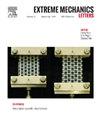Mechanical strength across metastatic lesions in trabecular bone: The interplay of microstructure and composition
IF 4.5
3区 工程技术
Q2 MATERIALS SCIENCE, MULTIDISCIPLINARY
引用次数: 0
Abstract
Pathological bone fractures are a prevalent complication associated with metastatic cancer. However, the fragility associated with bone metastasis exhibits distinct characteristics that are not adequately addressed by current fracture risk assessment systems, which are primarily designed for osteoporosis. To understand how metastasis impairs trabecular bone strength, we experimentally measured mechanical strain across osteolytic and osteoblastic metastatic lesions under axial compression using mechanical testing coupled with micro-computed tomography (micro-CT) and digital volume correlation (DVC) method. We then attempted to evaluate the correlation between this mechanical strain and various parameters, including bone microstructure, bone mineral density, and bone fat-water concentration with the presence of trabecular bone, as assessed through high-resolution micro-CT and magnetic resonance imaging (MRI). This proof-of-concept study demonstrates a workflow that integrates mechanical testing and medical imaging data, enabling the potential to develop a quantitative correlation between local bone strength and the microstructural and compositional parameters measurable through medical imaging techniques. This innovative approach is helpful for identifying key factors influencing mechanical strength of metastatic bones and provides valuable insights for the development of new fracture risk assessment protocols for cancer patients.
骨小梁转移病灶的机械强度:微观结构和组成的相互作用
病理性骨折是与转移性癌症相关的常见并发症。然而,与骨转移相关的易碎性表现出明显的特征,目前主要针对骨质疏松症设计的骨折风险评估系统没有充分解决这些特征。为了了解骨转移是如何损害骨小梁强度的,我们通过力学测试结合微计算机断层扫描(micro-CT)和数字体积相关(DVC)方法,实验测量了轴压下溶骨和成骨转移病变的机械应变。然后,我们试图通过高分辨率微ct和磁共振成像(MRI)评估这种机械应变与各种参数之间的相关性,包括骨微结构、骨矿物质密度和骨脂水浓度与小梁骨的存在。这项概念验证研究展示了一个集成机械测试和医学成像数据的工作流程,从而有可能开发出局部骨强度与通过医学成像技术可测量的显微结构和成分参数之间的定量相关性。这种创新的方法有助于确定影响转移性骨机械强度的关键因素,并为癌症患者制定新的骨折风险评估方案提供有价值的见解。
本文章由计算机程序翻译,如有差异,请以英文原文为准。
求助全文
约1分钟内获得全文
求助全文
来源期刊

Extreme Mechanics Letters
Engineering-Mechanics of Materials
CiteScore
9.20
自引率
4.30%
发文量
179
审稿时长
45 days
期刊介绍:
Extreme Mechanics Letters (EML) enables rapid communication of research that highlights the role of mechanics in multi-disciplinary areas across materials science, physics, chemistry, biology, medicine and engineering. Emphasis is on the impact, depth and originality of new concepts, methods and observations at the forefront of applied sciences.
 求助内容:
求助内容: 应助结果提醒方式:
应助结果提醒方式:


